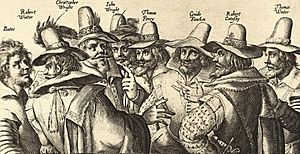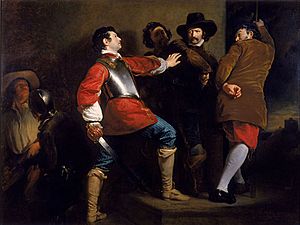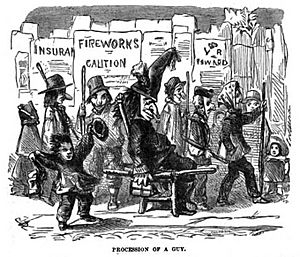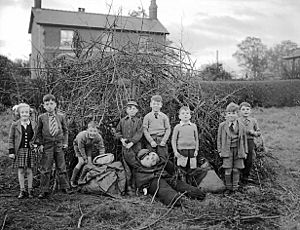Guy Fawkes facts for kids
Guy Fawkes (born 13 April 1570 – died 31 January 1606), also known as Guido Fawkes, was an English Catholic. He was part of a group of revolutionaries who planned the famous Gunpowder Plot. This group wanted to kill King James I and replace him with a Catholic ruler.
The plot was discovered just before Parliament was set to meet on November 5, 1605. Fawkes was found and arrested in a cellar, near the gunpowder, waiting to light it. Eight men, including Fawkes, were put on trial for a very serious crime against the king. They were found guilty and faced severe punishment in Westminster, London. Guy Fawkes died before he could be hanged.
Every year on November 5, people in the UK remember this event during Guy Fawkes Night. They light big bonfires, set off fireworks, and burn figures of Fawkes, often called 'the guy'.
Contents
Guy Fawkes' Early Life

Guy Fawkes was born in 1570 in Stonegate, York, England. He was the second of four children. His parents, Edward and Edith Fawkes, were part of the Church of England. However, his mother's family were Catholic.
Guy's father died in 1579 when Guy was eight years old. His mother later married a Catholic man named Dionis Baynbrigge. Guy likely became Catholic through his new family and his time at St. Peter's School in York. Many people at the school, including the headmaster, were Catholic. Some of Guy's school friends later became priests or were involved in the Gunpowder Plot with him.
After school, Fawkes worked for a nobleman, Anthony Browne. He later worked for Anthony's grandson.
Guy Fawkes' Military Career
In 1591, Guy Fawkes sold the land he inherited from his father. He then traveled to Europe to fight in the Eighty Years' War. This war was between Catholic Spain and the new Dutch Republic. England was also at war with Spain at this time.
Fawkes joined an English Catholic commander named Sir William Stanley. Stanley had switched sides to fight for Spain. Fawkes became a junior officer and fought well in battles. By 1603, he was recommended to become a captain.
That same year, he went to Spain to ask for help for a Catholic uprising in England. He started using the Italian version of his name, Guido. He described King James I as a "heretic" (someone who believes differently from the official religion) and said the king wanted to remove all Catholics from England. He also said that England and Scotland would not get along for long. Although he was treated kindly, the King of Spain did not offer him any help.
The Gunpowder Plot Plan

In 1604, Fawkes joined a small group of English Catholics. Their leader was Robert Catesby. They planned to kill the Protestant King James I. They wanted to replace him with his daughter, Princess Elizabeth, who was next in line to the throne after her brothers.
One of the plotters, Thomas Percy, gained access to a house in London near the Parliament building. Fawkes pretended to be Percy's servant, using the name John Johnson. The plotters rented a room under the Parliament building. It was dirty and unused, making it a perfect place to hide gunpowder. Fawkes said they brought in 20 barrels of gunpowder at first, then 16 more. However, the opening of Parliament was delayed until November 5 due to the plague.
How the Plot Was Discovered
Some of the plotters worried about other Catholics who would be in Parliament. On October 26, Lord Monteagle received an anonymous letter. It warned him to stay away from Parliament because "they shall receive a terrible blow this parliament."
The plotters quickly learned about the letter. But they thought it was a joke and decided to continue with their plan. Fawkes checked the cellar on October 30 and reported that nothing had been touched.
However, Lord Monteagle was suspicious and showed the letter to King James. The King ordered Sir Thomas Knyvet to search the cellars under Parliament. Knyvet did this in the early hours of November 5. Fawkes had been in the cellar since the night before, ready with a slow match and a watch to time the explosion. He was found leaving the cellar just after midnight and was arrested. Inside, the barrels of gunpowder were found hidden under piles of wood and coal.
Trial and Punishment
The trial for eight of the plotters began on January 27, 1606. The jury found all of them guilty of a very serious crime against the king.
On January 31, 1606, Fawkes and three others were taken from the Tower of London to Westminster. This was the same area where they had tried to destroy the Parliament building. Guy Fawkes died before he could be hanged. After the punishment, their bodies were sent to different parts of the kingdom. This was a warning to anyone else who might think about betraying the king.
Guy Fawkes in Books and Movies
Guy Fawkes and the Gunpowder Plot have appeared in many popular stories. Here are some examples:
- 1842: Guy Fawkes: A Historical Romance by William Harrison Ainsworth. This novel shows Fawkes and Catholics in a more positive light.
- 1847: Jane Eyre by Charlotte Brontë. The character Jane is compared to Guy Fawkes because she seems to be always planning something.
- 1850: David Copperfield by Charles Dickens. The Gunpowder Plot is mentioned when a character has to make a complicated plan.
- 1886: Billy Budd by Herman Melville. Fawkes is mentioned in this story.
- 1925: The Hollow Men by T. S. Eliot. This famous poem starts with a direct reference to Fawkes: "A penny for the Old Guy."
- 1953: Fahrenheit 451 by Ray Bradbury. The main character is named Guy Montag, partly after Guy Fawkes. He plans to burn houses to challenge the government.
- 1982: V for Vendetta by Alan Moore. This graphic novel is about a future Britain ruled by a harsh government. The main character, V, wears a Guy Fawkes mask.
- 1998: Harry Potter and the Chamber of Secrets by J. K. Rowling. In the Harry Potter series, Dumbledore's phoenix is named Fawkes after Guy Fawkes.
- 2005: V for Vendetta (film). This movie shows parts of the Gunpowder Plot story and is based on Alan Moore's graphic novel.
The Guy Fawkes Poem
This poem is often recited on Guy Fawkes Night:
Remember, remember! The fifth of November, The Gunpowder treason and plot; I know of no reason Why the Gunpowder treason Should ever be forgot! Guy Fawkes and his companions Did the scheme contrive, To blow the King and Parliament All up alive. Threescore barrels, laid below, To prove old England's overthrow. But, by God's providence, him they catch, With a dark lantern, lighting a match! A stick and a stake For King James's sake! If you won't give me one, I'll take two, The better for me, And the worse for you. Holloa, boys! holloa, boys! make the bells ring! Holloa, boys! holloa boys! God save the King! Hip, hip, hooor-r-r-ray!
See also
Images for kids
-
Fawkes was baptised at the church of St Michael le Belfrey, York, next to York Minster (seen at left).
More Information
 In Spanish: Guy Fawkes para niños
In Spanish: Guy Fawkes para niños





